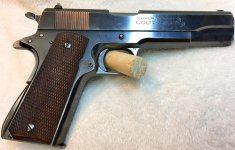The M1905 Colt was not designed for the later M1911 .45 cartridge. Rather it used a cartridge having a lighter 200 grain bullet at a lower chamber pressure (cataloged as the .45 Colt's Automatic). While post-1911 .45 ACP ammunition can be used in the M1905, sooner or later it will result in cracking of the slide around the barrel wedge at the front of the slide. Use of .38 Super ammunition in the Colt M1902 and M1903 pistols can result in the same slide failure. There is no good way to repair it. I have seen many M1902/03/05 pistols with such slide cracks. I once owned a M1903 in fairly high condition, and I handloaded only lead bullet .38 ACP loads just powerful enough to function its action reliably.
I believe that the development of the .357 Magnum cartridge and revolver for LE use by S&W was a direct competitive challenge to Colt's .38 Super pistol for the LE market, and most certainly negatively affected the future market popularity of the Colt .38 Super. Remember that there were also numerous powerful 9mm cartridges similar to the .38 Super in existence prior to its development. such as the 9mm Steyr , the 9mm Mauser Export, and the 9mm Bergman-Bayard (9mm Largo). And several other 9mm cartridges most have never heard of.
%%%%%
I agree about the 1905 Colt as a convenient way to establish the feasibility of a .45 semi auto toward deveopment of a modern replacement of the unsatifactory .38 revolver. The success was the 1911 after a variety of interim development improve models.
About cracking frames at the muzzle slide lock, I restored two of them by closing the crack mechanically best I could, then ground into the crack deep enuf to get MIG weld all the way thru & put weld in to refit for the cross slide. When near final finish I heated the worked area to a red, finished polish & had it Turnbulls charcoal blue. They cautioned the blue wouldn't hide the weld which was true because I knew where to look but nobody discovered it.
Another similar 1905 was cracked over 1/16", so much an owner had shimmed the forward movement of the side, probably to restore alignment with the disconnector. Same fix.
I had a 1902 with major distress by bubba filing & grinding, about welds to fix. One one I failed to do my red reheat & it was visible but all the others were as above.
My data base is small of about 10 1905s & over 20 .38s & never saw one of them with distress in the muzzle crack area, which leads me to believe the frequent Super caution is overblown -- something like the cautions about +P ammo for business but not for practice ----->







